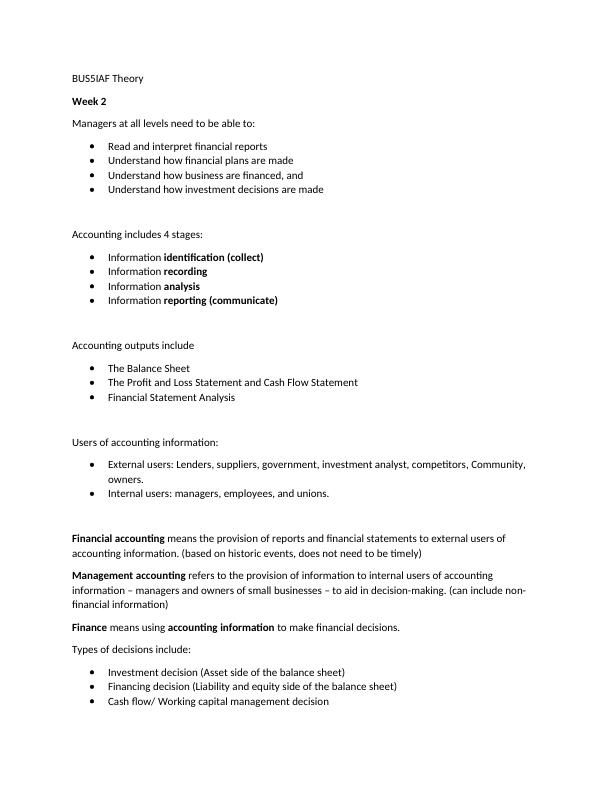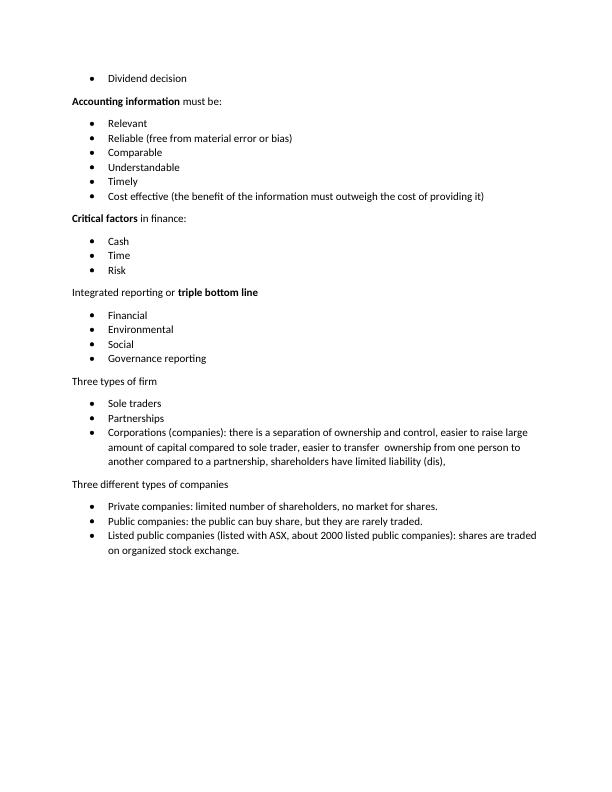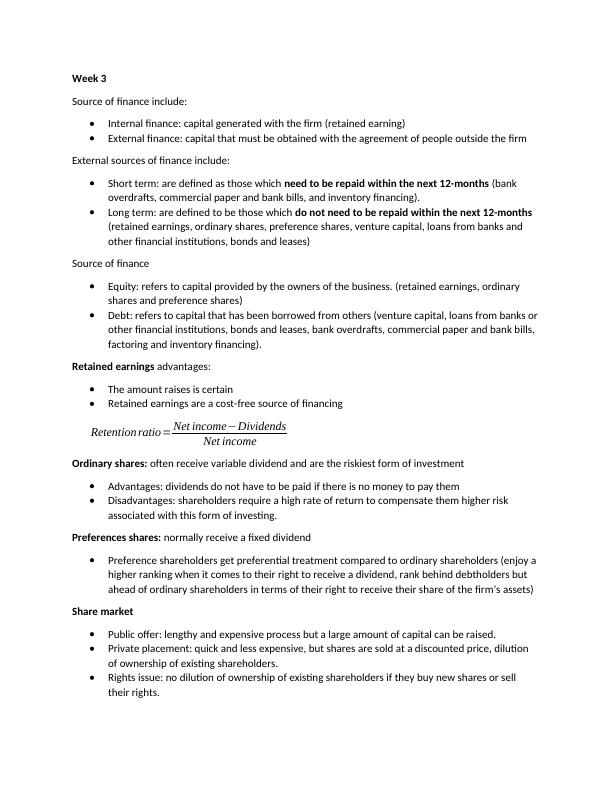BUS5IAF Introduction to Accounting and Finance : Assignment
10 Pages3372 Words97 Views
Added on 2021-03-23
BUS5IAF Introduction to Accounting and Finance : Assignment
Added on 2021-03-23
ShareRelated Documents
BUS5IAF TheoryWeek 2Managers at all levels need to be able to:Read and interpret financial reportsUnderstand how financial plans are madeUnderstand how business are financed, andUnderstand how investment decisions are madeAccounting includes 4 stages:Information identification (collect)Information recordingInformation analysisInformation reporting (communicate)Accounting outputs includeThe Balance SheetThe Profit and Loss Statement and Cash Flow StatementFinancial Statement AnalysisUsers of accounting information:External users: Lenders, suppliers, government, investment analyst, competitors, Community, owners.Internal users: managers, employees, and unions.Financial accounting means the provision of reports and financial statements to external users of accounting information. (based on historic events, does not need to be timely)Management accounting refers to the provision of information to internal users of accounting information – managers and owners of small businesses – to aid in decision-making. (can include non-financial information)Finance means using accounting information to make financial decisions.Types of decisions include:Investment decision (Asset side of the balance sheet)Financing decision (Liability and equity side of the balance sheet)Cash flow/ Working capital management decision

Dividend decisionAccounting information must be:RelevantReliable (free from material error or bias)ComparableUnderstandableTimelyCost effective (the benefit of the information must outweigh the cost of providing it)Critical factors in finance: CashTimeRiskIntegrated reporting or triple bottom lineFinancialEnvironmentalSocialGovernance reportingThree types of firmSole tradersPartnershipsCorporations (companies): there is a separation of ownership and control, easier to raise large amount of capital compared to sole trader, easier to transfer ownership from one person to another compared to a partnership, shareholders have limited liability (dis), Three different types of companiesPrivate companies: limited number of shareholders, no market for shares.Public companies: the public can buy share, but they are rarely traded.Listed public companies (listed with ASX, about 2000 listed public companies): shares are traded on organized stock exchange.

Week 3Source of finance include:Internal finance: capital generated with the firm (retained earning)External finance: capital that must be obtained with the agreement of people outside the firmExternal sources of finance include:Short term: are defined as those which need to be repaid within the next 12-months (bank overdrafts, commercial paper and bank bills, and inventory financing).Long term: are defined to be those which do not need to be repaid within the next 12-months(retained earnings, ordinary shares, preference shares, venture capital, loans from banks and other financial institutions, bonds and leases)Source of financeEquity: refers to capital provided by the owners of the business. (retained earnings, ordinary shares and preference shares)Debt: refers to capital that has been borrowed from others (venture capital, loans from banks orother financial institutions, bonds and leases, bank overdrafts, commercial paper and bank bills, factoring and inventory financing).Retained earnings advantages:The amount raises is certainRetained earnings are a cost-free source of financingRetentionratio=Netincome−DividendsNetincomeOrdinary shares: often receive variable dividend and are the riskiest form of investmentAdvantages: dividends do not have to be paid if there is no money to pay themDisadvantages: shareholders require a high rate of return to compensate them higher risk associated with this form of investing.Preferences shares: normally receive a fixed dividendPreference shareholders get preferential treatment compared to ordinary shareholders (enjoy a higher ranking when it comes to their right to receive a dividend, rank behind debtholders but ahead of ordinary shareholders in terms of their right to receive their share of the firm’s assets)Share marketPublic offer: lengthy and expensive process but a large amount of capital can be raised.Private placement: quick and less expensive, but shares are sold at a discounted price, dilution of ownership of existing shareholders.Rights issue: no dilution of ownership of existing shareholders if they buy new shares or sell their rights.

End of preview
Want to access all the pages? Upload your documents or become a member.
Related Documents
External Long Term Finance for Unincorporated and Incorporated Businesseslg...
|6
|1246
|239
Introduction to Corporate Financelg...
|18
|4970
|115
Financial Decision of ABC Ltd | Assignmentlg...
|14
|4368
|129
Income Generation Opportunity - PDFlg...
|21
|4768
|51
Finance for Managers Assignment Sample PDFlg...
|22
|8076
|154
Sources of Finance - Assignmentlg...
|24
|4357
|657
